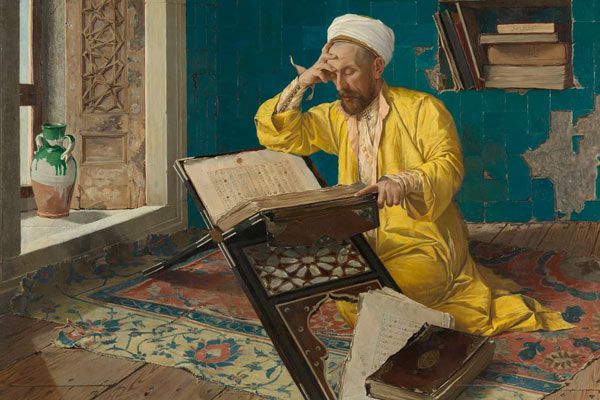
Art of the World in the Belvedere
From September 9, 2021, to March 22, 2022, the Belvedere in Vienna presents three works from its (mostly Eurocentric) collection that reflect the creative tension between East and West.
Osman Hamdi Bey - Meditating on the Quran - 1902Saleh Ben Jaggia Raden - Tigers Fighting over a dead Javanese - 1870
Source: Belvedere, Vienna. Images: Osman Hamdi Bey, Meditating on the Qur'an, 1902. Photograph: Johannes Stoll / Belvedere, Vienna ·· Saleh Ben Jaggia Raden, Tigers fighting over a dead Javanese, 1870. Photograph: Johannes Stoll / Belvedere, Vienna
The three works in the exhibition are "Tigers Fighting over a Dead Javanese" (1870) by Raden Saleh from Indonesia, "Meditating on the Qur'an" (1902) by Osman Hamdi Bey from Turkey, and "Nāser ad-Din, the Shah of Persia" by Hakob Hovnatanyan, an Armenian artist from present-day Georgia. According to the museum, "in our globalized age, looking back at the myriad cultural interactions that occurred during the nineteenth century feels more relevant than ever".
Osman Hamdi Bey (1842-1910) was one of the most important cultural figures of 19th-century Turkey. In addition to his fame as a painter, he was also an important archaeologist and populariser, founding the Istanbul Archaeological Museum. In 2019, his "Girl Reciting the Koran" -a painting with a similar subject matter to the one on display at the Belvedere- was auctioned for $7.8 million, a record price for a Turkish artist.
Raden Saleh (Saleh Ben Jaggia Raden, 1807-1880) was one of the pioneers of modern art in Indonesia, incorporating the technique he learned during his training in the Netherlands into the tradition of his country. In the Netherlands, he was fascinated by the figure of a lion he observed during a circus performance, and thereafter several of his most famous works - such as "Tigers Fighting over a Dead Javanese"- incorporate figures of wild animals.
Hakob Hovnatanyan (1806-1881), born in Armenia (present-day Georgia), moved to Iran, where he developed his career mainly as a portraitist, influenced by the miniatures of the Persian tradition. The Belvedere's own work, "The Shah of Persia" (Naser al-Din Shah Qajar), is considered one of his masterpieces.
Read the full article

